GE 40374, 40350 User Manual
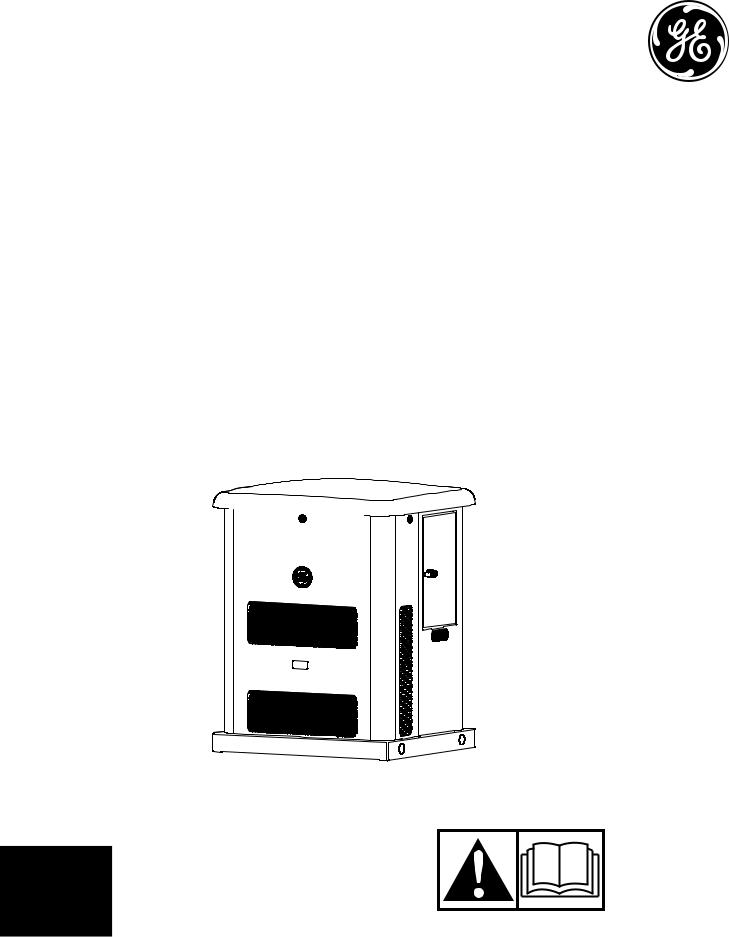
GE Home Generator Systems
Home Generator System
Model 040350 and Model 040374
Installation and
Start-Up Manual |
|
NOT |
REPRODUCTION |
for |
|

Thank you for purchasing this quality-built GE home generator. We’re pleased that you’ve placed your confidence in the GE brand. When operated and maintained according to the instructions in the operator’s manual, your home generator will provide many years of dependable service.
This manual contains safety information to make you aware of the hazards and risks associated with standby generators and how to avoid them. This product is only for use as an optional generator system which provides an alternate source of electric power and to serve loads such as heating, refrigeration systems, and communication systems that, when stopped during any power outage, could cause discomfort or inconvenience.
Save these original instructions for future reference.
This generator requires professional installation before use. The installer should follow the instructions completely.
Where to Find Us
You never have to look far to find support and service for your generator. For quick service when you need it most fill out the information below and keep your original receipt with this manual. You may contact Customer Service at (888) 575-8226, or click on SERVICE & SUPPORT at www.homestandbygeneratorsystems.com, which provides a list of authorized dealers.
For Future Reference
Please fill out the information below and keep with your receipt to assist in unit identification for future purchase issues.
Date of Purchase |
REPRODUCTION |
|
|
NOT |
|
Generator |
|
for |
|
Model umber
Model Revision
Serial Number
Engine
Model Number
2
Table of Contents
Safety Rules . . . . . . . . . . . . . . . . |
. 4 |
|
Installation . . . . . . . . . . . . . . . . . |
7 |
|
Delivery Inspection . . . . . . . . . . . . . . . . . |
|
8 |
Shipment Contents . . . . . . . . . . . . . . . . . |
|
8 |
Installation Checklist - GE Home Generator Systems . . |
. . . . . . . . . . . |
9 |
Generator Placement . . . . . . . . . . . . . . . . |
. 11 |
|
Placement of Standby Generator to REDUCE THE RISK OF CARBON MONOXIDE POISONING 12 |
||
Placement of Standby Generator to REDUCE THE RISK OF FIRE . |
. . |
. |
. . . . |
14 |
|||||||
Other General Location Guidelines . . |
|
. . |
. . . . . . |
. |
. |
. . |
. |
. |
. |
16 |
|
Electrical and Fuel Inlet Locations . . |
|
. . |
. . . . . . |
. |
. |
. . |
. |
. |
. |
|
17 |
Lifting the Generator . . . . . . . . |
|
. . |
. . . . . . |
. |
|
|
|
|
|
|
18 |
Concrete Anchoring of Unit . . . . . |
|
. . |
. . . . . . |
. |
. |
. . |
|
18 |
|||
Access Panels . . . . . . . . . . . . . . . . . . . . . . |
|
. . . . |
. . . . . . . . . . . . |
. . . |
. . |
. . . |
. . . |
. . |
. . . . . . . . |
. |
19 |
The Gaseous Fuel System . . . . . . |
|
. . |
. . . . . . |
. |
. |
. |
21 |
||||
System Connectors . . . . . . . . . |
|
. . |
. . . . . . |
|
|
|
25 |
||||
Generator Ac Connection System . . |
|
. . |
. . . . . . |
. . |
. |
. |
. . |
. |
26 |
||
Grounding the Generator . . . . . . |
|
. . |
. . . . . . |
. |
. |
. |
26 |
||||
Power Connections from Generator to |
ransfer Switch |
. . |
. |
. . . . . . . . |
|
27 |
|||||
System Control Board . . . . . . . |
|
. . |
. . . . . . |
. . |
|
|
28 |
||||
Menu . . . . . . . . . . . . . . . |
|
. . |
|
|
|
29 |
|||||
General Set Up Screen . . . . . . . |
|
. . |
. . . . . . |
. . |
|
|
30 |
||||
Control Panel Prompts . . . . . . . |
|
. . |
. . . . . . |
. . |
|
31 |
|||||
NOT |
|
|
|
|
|
|
|
|
|
|
|
Advanced Settings Screen . . . . . . |
|
. . |
. . . . . . |
. |
. |
. |
32 |
||||
Service Code Detection System .for. . |
|
. . |
. . . . . . |
. . |
. |
. |
. . |
33 |
|||
Final Installation Considerations . . . . . |
REPRODUCTION. . . . . . . . . . . . . . . . . . . . . . . . . . . . . . . . . . . . . |
. |
33 |
||||||||
Initial Start-up (No Load) . . . . . . |
|
34 |
|||||||||
|
. . |
. . . . . . |
. . |
. |
|
||||||
Operation . . . . . . . . . . |
|
. . |
. . . . . |
|
|
35 |
|||||
Automatic Operation Sequence . . . |
|
. . |
. . . . . . |
. . |
. |
. |
. . |
35 |
|||
Setting Exercise Timer . . . . . . . |
|
. . |
. . . . . . |
. . |
|
35 |
|||||
Wireless Monitor . . . . . . . . . . . . . . . . . . . |
|
. . . . |
. . . . . . . . . . . . |
. . . |
. . |
. . . |
. . . |
. . |
. . . . . . . . |
. |
36 |
Installation Inspection . . . . . . . |
|
. . |
. . . . . . |
. . |
|
38 |
|||||
Schematic / Wiring Diagrams . . . . |
|
. . |
. . . . . . |
. |
. |
. . |
. |
41 |
|||
3
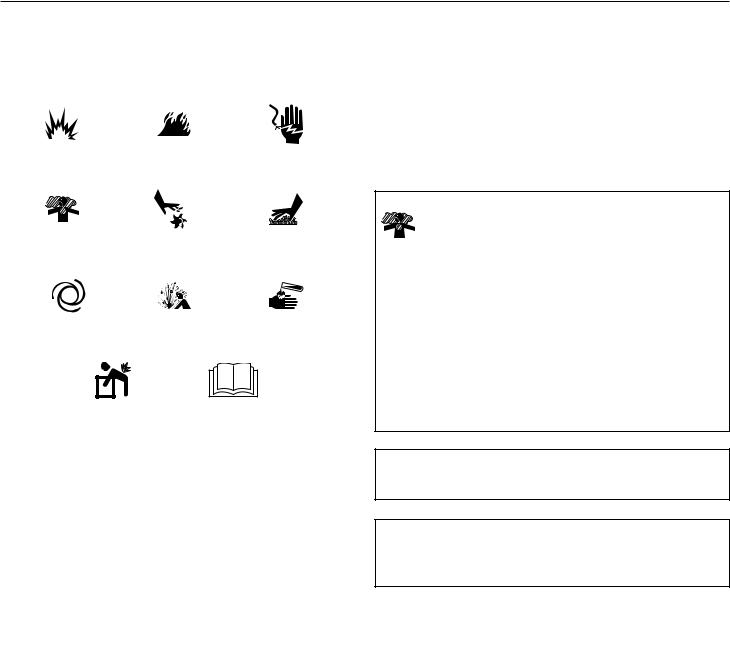
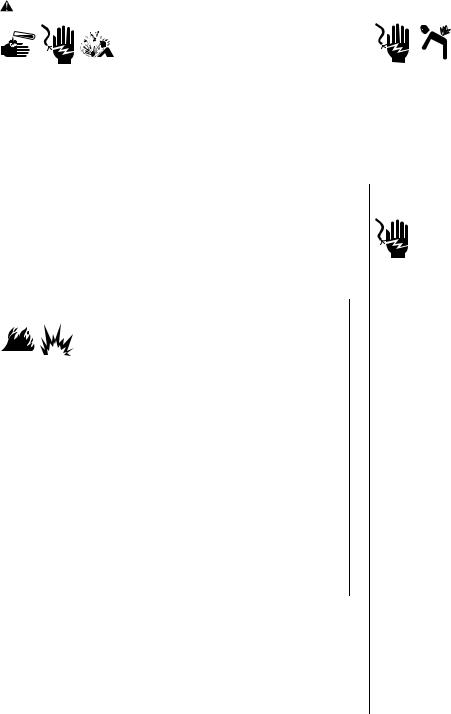
|
WARNING Storage batteries give off explosive hydrogen gas |
|
|
WARNING Hazardous Voltage - Contact with power lines could |
||||
|
during recharging. |
|
|
|
|
|
|
cause electric shock or burn, resulting in death or |
|
Slightest spark will ignite hydrogen and |
|
|
|
|
serious injury. |
||
|
cause explosion, resulting in death or |
|
|
|
|
Lifting Hazard / Heavy Object - Could result in |
||
|
serious injury. |
|
|
|
|
|
|
serious injury. |
Battery electrolyte fluid contains acid and is extremely caustic. |
|
• |
If lifting or hoisting equipment is used, DO NOT contact any |
|||||
Contact with battery contents could cause severe chemical burns. |
|
|
power lines. |
|||||
A battery presents a risk of electrical shock and high short |
|
• |
DO NOT lift or move generator without assistance. |
|||||
circuit current. |
|
|
|
|||||
|
|
|
• |
Use lifting pipes as described in Lifting the Generator. |
||||
• |
DO NOT dispose of battery in a fire. Recycle battery. |
|
||||||
|
• |
DO NOT lift unit by roof as damage to generator will occur. |
||||||
• |
DO NOT allow any open flame, spark, heat, or lit cigarette during |
|
||||||
|
|
|
|
|
||||
|
and for several minutes after charging a battery. |
|
|
|
|
|
|
|
• |
DO NOT open or mutilate the battery. |
|
|
|
|
|
|
|
|
|
|
|
WARNING Generator produces hazardous voltage. |
||||
• |
Wear protective goggles, rubber apron, rubber boots and |
|
|
Failure to properly ground generator could result |
||||
|
rubber gloves. |
|
|
|
|
in electrocution. |
||
• |
Remove watches, rings, or other metal objects. |
|
|
|
Failure to isolate generator from utility power could result |
|||
|
|
|
in death or serious injury to electric utility workers due to |
|||||
• |
Use tools having insulated handles. |
|
|
|
|
|||
|
|
|
|
backfeed of electrical energy. |
||||
|
|
|
|
|
|
|||
|
|
|
|
|
• |
DO NOT touch bare wires or bare receptacles. |
||
|
|
|
|
|
• |
DO NOT use generator with electrical cords which are worn, |
||
|
WARNING Propane and Natural Gas are extremely flammable |
|||||||
|
|
|
frayed, bare or otherwise damaged. |
|||||
|
and explosive, which could cause burns, fire or |
|
|
|||||
|
|
• |
DO NOT handle generator or electrical cords while standing in |
|||||
|
explosion resulting in death or serious injury |
|
||||||
|
. |
|
|
|
|
water, while barefoot, or while hands or feet are wet. |
||
|
|
|
|
• |
If you must work around a unit while it is operating, stand on an |
|||
• |
Install the fuel supply system according to NFPA 37 and other |
|
||||||
|
|
insulated dry surface to reduce the risk of a shock hazard. |
||||||
|
applicable fuel-gas codes. |
|
|
|
• |
DO NOT allow unqualified persons or children to operate or |
||
• |
Before placing the generator into service, the fuel system lines |
|
||||||
|
|
service generator. |
||||||
|
must be properly purged and leak tested. |
|
|
• |
In case of an accident caused by electrical shock, immediately |
|||
• |
After the generator is installed, youNOTshould inspect the fuel |
|
||||||
|
|
shut down the source of electrical power and contact the local |
||||||
|
system periodically. |
for |
|
|
|
authorities. Avoid direct contact with the victim. |
||
• |
NO leakage is permitted. |
|
|
• |
Despite the safe design of the residential generator, operating |
|||
• |
|
|
|
|
this equipment imprudently, neglecting its maintenance or being |
|||
DO NOT operate engine if smell of fuel is present or other |
|
|
||||||
|
explosive conditions exist. |
|
|
|
|
careless could cause possible injury or death. |
||
• |
|
|
REPRODUCTION• Remain alert at all times while working on this equipment. |
|||||
DO NOT smoke around the generator. Wipe up any oil spills |
|
|
Never work on the equipment when you are physically or |
|||||
|
immediately. Ensure that no combustible materials are left in the |
|
|
|||||
|
generator compartment. Keep the area near the generator clean |
|
|
mentally fatigued. |
||||
|
and free of debris. |
|
|
|
• |
Before performing any maintenance on the generator, disconnect |
||
|
|
|
|
|
|
the battery cable indicated by a NEGAtiVE, NEG or (-) first. When |
||
|
|
|
|
|
|
|||
|
|
|
|
|
|
finished, reconnect that cable last. |
||
|
|
|
|
|
|
|
|
|

WARNING Exhaust heat/gases could ignite combustibles |
|
|
CAUTION Installing the 15A fuse could cause the engine |
||
or structures resulting in death or serious injury. |
|
|
to start at any time without warning resulting in minor or |
||
Contact with muffler area could cause burns |
|
|
moderate injury. |
||
resulting in serious injury. |
|
|
• |
Observe that the 15 Amp fuse has been removed from the control |
|
|
|
|
|
||
• DO NOT touch hot parts and AVOID hot exhaust gases. |
|
|
panel for shipping. |
||
|
• |
DO NOT install this fuse until all plumbing and wiring has been |
|||
• Allow equipment to cool before touching. |
|
|
|||
|
|
|
completed and inspected. |
||
• Exhaust outlet side of weatherproof enclosure must have |
|
|
|||
|
|
|
|||
at least 5 ft. (1.5 m) minimum clearance from any structure, |
|
|
|
||
|
|
CAUTION Excessively high operating speeds could result in |
|||
shurbs, trees or any kind of vegetation. |
|
|
|
||
|
|
minor injury and/or equipment damage. |
|||
• Standby generator weatherproof enclosure must be at least |
|
||||
|
Excessively low speeds impose a heavy load on generator. |
||||
5 ft. (1.5 m) from windows, doors, any wall opening, shrubs |
|
||||
|
• |
DO NOT tamper with governed speed. Generator supplies correct |
|||
or vegetation over 12 inches (30.5 cm) in height. |
|
||||
|
|
rated frequency and voltage when running at governed speed. |
|||
• Standby generator weatherproof enclosure must have |
|
|
|||
|
• |
DO NOT modify generator in any way. |
|||
a minimum of 5 ft. (1.5 m) overhead clearance from any |
|
||||
|
|
|
|||
structure, overhang or trees. |
|
|
|
NOTICE Improper treatment of generator could damage it and |
|
• DO NOT place weatherproof enclosure under a deck or |
|
||||
|
shorten its life. |
||||
other type of structure that may confine airflow. |
|
||||
|
• |
Use generator only for intended uses. |
|||
• Use only flexible steel fuel line provided. Connect provided |
|
||||
|
• |
If you have questions about intended use, contact your |
|||
fuel line to generator, DO NOT use with or substitute any |
|
||||
other flexible fuel line. |
|
|
|
|
authorized dealer. |
• Smoke detector(s) MUST be installed and maintained |
|
• Operate generator only on level surfaces. |
|||
|
|
REPRODUCTION-electrical output is lost; |
|||
indoors according to the manufacturer’s instructions/ |
|
• |
Adequate, unobstructed flow of cooling and ventilating air is |
||
recommendations. Carbon monoxide alarms cannot detect |
|
|
critical for correct generator operation. |
||
smoke. |
|
|
|
• |
The access panels/door must be installed whenever the unit |
• Keep at least minimum distances shown in General |
|
|
is running. |
||
Location Guidelines to insure for proper generator cooling |
|
• |
DO NOT expose generator to excessive moisture, dust, dirt, or |
||
and maintenance clearances. |
|
|
|
|
corrosive vapors. |
• It is a violation of California Public Resource Code, Section |
|
• Remain alert at all times while working on this equipment. |
|||
4442, to use or operate the engine on any forest-covered, |
|
|
Never work on the equipment when you are physically or |
||
|
NOT |
|
|
|
mentally fatigued. |
brush-covered, or grass-covered land unless the exhaust |
|
|
|||
system is equipped with a spark arrester, as defined in |
|
• |
NOT start engine with air cleaner or air cleaner cover removed. |
||
Section 4442, maintained in effective working order. Other |
|
• |
DO NOT insert any objects through cooling slots. |
||
states or federal jurisdictions may have similar laws. |
|
||||
Contact Briggs and Stratton, retailer, dealer to obtain a |
|
• |
DO NOT use the generator or any of its parts as a step. Stepping |
||
spark arrester designed for the exhaust system installed on |
|
|
on the unit could cause stress and break parts. This may result in |
||
this engine. |
|
|
|
|
dangerous operating conditions from leaking exhaust gases, fuel |
• Replacement parts must be the same and installed in the |
|
|
leakage, oil leakage, etc. |
||
same position as the original parts.for |
|
• |
If connected devices overheat, turn them off and disconnect them |
||
|
|
|
|
|
from generator. |
|
|
|
|
|
|
|
|
|
|
• |
Shut off generator and contanct an authorized deaker if: |
|
|
|
-equipment sparks, smokes, or emits flames; |
||
WARNING Starter and other rotating parts could entangle |
|
|
|||
hands, hair, clothing, or accessories resulting in |
|
|
-unit vibrates excessively; |
||
serious injury. |
|
|
|
|
-unit makes unusual noises. |
•NEVER operate generator without protective housings, covers, or guards in place.
•DO NOT wear loose clothing, jewelry or anything that could be caught in the starter or other rotating parts.
•Tie up long hair and remove jewelry.
•Before servicing, remove 15 Amp fuse from control panel and disconnect Negative (NEG or -) battery cable.
6

Installation
This product is only for use as an optional generator system which provides an alternate source of electric power and to serve loads such as heating, refrigeration systems, and communication systems that, when stopped during any power outage, could cause discomfort or inconvenience.
NOTICE This product does NOT qualify for either an emergency standby or legally required standby system as defined by NFPA 70 (NEC).
Every effort has been made to ensure that information in this manual is accurate and current. However, we reserve the right to change, alter, or otherwise improve the product and this document at any time without prior notice.
Only current licensed electrical and plumbing professionals should attempt home generator system installations. Installations must strictly comply with all applicable codes, industry standards, laws and regulations.
• Emergency generator systems are intended to |
|
|||
automatically supply illumination, power, or both, |
|
|||
to designated areas and equipment in the event of |
|
|||
failure of the normal supply. Emergency systems may |
|
|||
also provide power for such functions as ventilation |
|
|||
|
|
REPRODUCTION |
||
where essential to maintain life, where current |
|
|||
interruption of the normal supply would produce |
|
|||
serious life safety or health hazards. |
|
|
||
• Legally Required standby generator systems are |
|
|||
intended to automatically supply power to selected |
|
|||
loads in the event of failure of the normal source |
|
|||
which could create hazards or hamper rescue or fire- |
|
|||
fighting operations. |
NOT |
|
|
|
|
|
|
||
Home Owner Responsibilities |
|
|
||
|
|
|
|
|
|
for |
|
• Carbon monoxide detector(s) MUST be installed and |
|
• Read and follow the instructions given in the |
maintained indoors according to the manufacturer’s |
|||
operator’s manual. |
|
|
instructions/ recommendations. Smoke alarms |
|
• Follow a regular schedule in maintaining, caring for |
||||
cannot detect carbon monoxide gas. |
||||
and using your home generator, as specified in the |
• Smoke detector(s) MUST be installed and maintained |
|||
operator’s manual. |
|
|
||
|
|
indoors according to the manufacturer’s instructions/ |
||
recommendations. Carbon monoxide alarms cannot detect smoke.
Installing Dealer/Contractor Responsibilities
•Read and observe the safety rules.
•Install only an UL approved transfer switch that is compatible with the generator.
•Read and follow the instructions given in this installation and start-up manual.
•Installation must strictly comply with all applicable codes, industry standards, laws, and regulations.
•Allow sufficient room on all sides of the generator for maintenance and servicing.
7
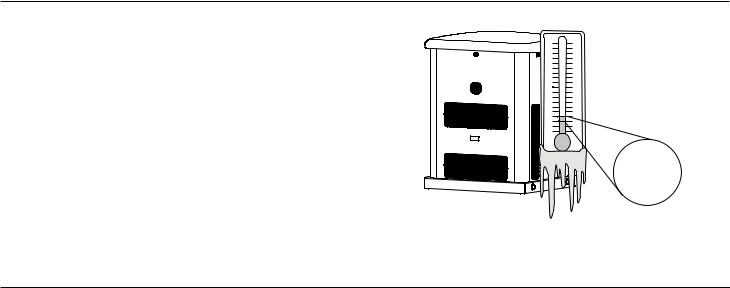
Cold Weather Kit
If operating the generator below 30°F (-1°C), it is HIGHLY RECOMMENDED that a Model 6262 Cold Weather Kit
(includes oil warmer and battery warmer) be installed on the 8kW units and that a Model 6030A Cold Weather Kit
(includes oil warmer and battery warmer) be installed on the 10kW units.
These items are available at your local servicing dealer.
For cold weather areas (below 0°F (-18°C)) it is also |
30°F (-1°C) |
|
recommended that a BCI, Size 26, wet lead-acid battery be |
||
|
||
used of 630 CCA minimum. |
|
If you need more information on this matter, please call (888) 575-8226, between 8:00 AM and 5:00 PM CT.
Unpacking Precautions
Avoid damage from dropping, bumping, collision, etc. Store and unpack carton with the proper side up, as noted on the
shipping carton. |
|
|
REPRODUCTION |
|||
|
|
|
|
|
||
Delivery Inspection |
|
|
|
|
|
|
|
|
|
||||
After removing the carton, carefully inspect the generator for |
|
|
||||
any damage that may have occurred during shipment. |
|
|
||||
If loss or damage is noted at time of delivery, have the |
|
|
||||
|
|
NOT |
|
|
|
|
person(s) making delivery note all damage on the freight bill |
|
|
||||
and affix his signature under the consignor’s memo of loss or |
|
|
||||
damage. If loss or damage is noted after delivery, separate |
|
|
||||
the damaged materials and contact the carrier for claim |
|
|
||||
|
|
|
for |
|
|
|
procedures. Parts damaged in shipping are not warranted. |
|
|
||||
Shipment Contents |
|
|
|
|
|
|
The home generator system is supplied with: |
|
ot included: |
||||
• |
Oil (5W30 Synthetic) |
|
|
|
• |
Carbon monoxide detector(s) |
• Flexible steel fuel line |
|
|
|
• |
Smoke detector(s) |
|
• Installation and start-up manual |
|
|
• |
Starting battery |
||
• |
Operator’s manual |
|
|
|
• Connecting wire and conduit |
|
• |
Spare access keys |
|
|
|
• |
Fuel supply valves/plumbing |
• Spare 15 Amp ATO-type fuse |
|
|
• Crane, lifting straps, chains or cables |
|||
• |
Remote wireless monitor |
|
|
|
• Two 60” lengths of 3/4” nominal minimum scheduled |
|
• |
Antenna |
|
|
|
|
40 steel pipe (NOT conduit) |
|
|
|
|
|
||
|
|
|
|
|
• Torque screwdriver, 5 to 50 inch-pound range |
|
|
|
|
|
|
• |
Voltage/frequency meter |
|
|
|
|
|
• Two (2) AA batteries for remote wireless monitor |
|
8

Installation Checklist - GE Home Generator Systems
Proper installation of the home generator requires the completion of the following tasks:
Carbon Monoxide (CO) Detector/ Smoke Detector |
|
|
|||
Carbon Monoxide (CO) detector(s) installed and in working |
Operation |
||||
order. |
|
|
|
||
|
|
|
|
||
Smoke detector(s) installed and in working order. |
Cold weather kit is installed in temperatures below XX°F |
||||
Placement |
|
|
|
(5°C). See Cold Weather Kit. |
|
|
|
|
Correct battery type is installed and fully charged. See |
||
Required permits have been obtained. |
|
||||
|
Final Installation Considerations. |
||||
Generator placed in an area free from Carbon Monoxide |
|||||
Generator engine oil level is at full mark. See Final |
|||||
(CO) buildup. See Placement of Standby Generator to |
|||||
Installation Considerations. |
|||||
Reduce the Risk of Carbon Monoxide Poisoning. |
|||||
Circuit breaker is in the ON position. |
|||||
Generator placed in an area compliant to NFPA 37. See |
|||||
Utility was shut off to test the operation of generator and |
|||||
Placement of Standby Generator to Reduce the Risk of |
|||||
Fire. |
|
|
|
transfer switch. Note any fault codes and make corrections |
|
Generator placed in an area free from water damage. See |
as required. |
||||
AC Voltage Output___________________________. |
|||||
Other General Location Guidelines. |
|
||||
Generator placed in an area free from utility and other |
Frequency Output___________________________. |
||||
home systems. See Other General Location Guidelines. |
|
||||
Generator placed in a debris free zone. See Other General |
|
||||
Location Guidelines. |
|
|
REPRODUCTION |
||
Generator placed on flat ground with provisions for water |
Owner Information |
||||
drainage.See Other General Location Guidelines. |
Name:______________________________________________ |
||||
Fuel |
|
|
|
Address: ___________________________________________ |
|
Generator is connected to fuel source with steel flexible |
___________________________________________________ |
||||
fuel line, has no fuel leaks and conforms to local codes. See |
Phone/e-mail:________________________________________ |
||||
The Gaseous Fuel System. |
|
|
Unit Information |
||
Proper fuel pressure has been measured with all gas |
|||||
|
NOT |
|
Generator Model:_____________________________________ |
||
appliances operating. See The Gaseous Fuel System. |
|||||
Fuel system has been configured for the proper fuel |
Generator Serial Number:______________________________ |
||||
supply: Natural gas (NG) or liquefied petroleum ( LP). See |
|
||||
Fuel Conversion. |
|
|
|
nstalling Contractor Information |
|
Fuel type: (circle one) |
G |
LP |
|
Name:______________________________________________ |
|
Fuel pipe size used: (circle one) |
3/4” 1” 1-1/4” 1-1/2” |
Address: ___________________________________________ |
|||
See NFPA 54. |
|
|
|
___________________________________________________ |
|
Fuel pressure at fuel inlet port withforgenerator on and at |
Phone/FAX:__________________________________________ |
||||
full load and all gas appliances turned on and operating |
|||||
____________________. |
|
|
|
|
|
Electrical |
|
|
|
Electrician: __________________________________________ |
|
Generator neutral is connected to Automatic Transfer |
Signature:___________________________________________ |
||||
Switch. See Generator AC Connection System. |
|
||||
Generator is grounded. See Grounding the Generator and |
Plumber: ___________________________________________ |
||||
NFPA 70,NEC. |
|
|
|
Signature: _ _________________________________________ |
|
Generator is connected to the transfer switch with the |
|||||
Inspector Information |
|||||
specified wiring. See Utility Circuit Connection and |
|||||
Transfer Switch Communication. |
|
Name:______________________________________________ |
|||
Generator is connected to the transfer switch with the |
Address:_ ___________________________________________ |
||||
specified wiring. #18AWG twisted pair wiring from the |
___________________________________________________ |
||||
generator control panel to the transfer switch is installed |
|||||
Title:_______________________________________________ |
|||||
in a separate conduit from high voltage wires unless |
|||||
Inspection Date:______________________________________ |
|||||
the insulation rating on all wiring is rated for 600V See |
|||||
Transfer Switch Communication.
Dipswitches in most transfer switches must be set to correspond to the wattage of the generator. See Transfer
Switch Operator/Installation Manual.
This generator has been installed per the manufacturer’s instructions:
Installing Contractor Signature: _______________________________
Date:_____________________________________________________
9
NOT for
REPRODUCTIONIntentionally Left Blank
10
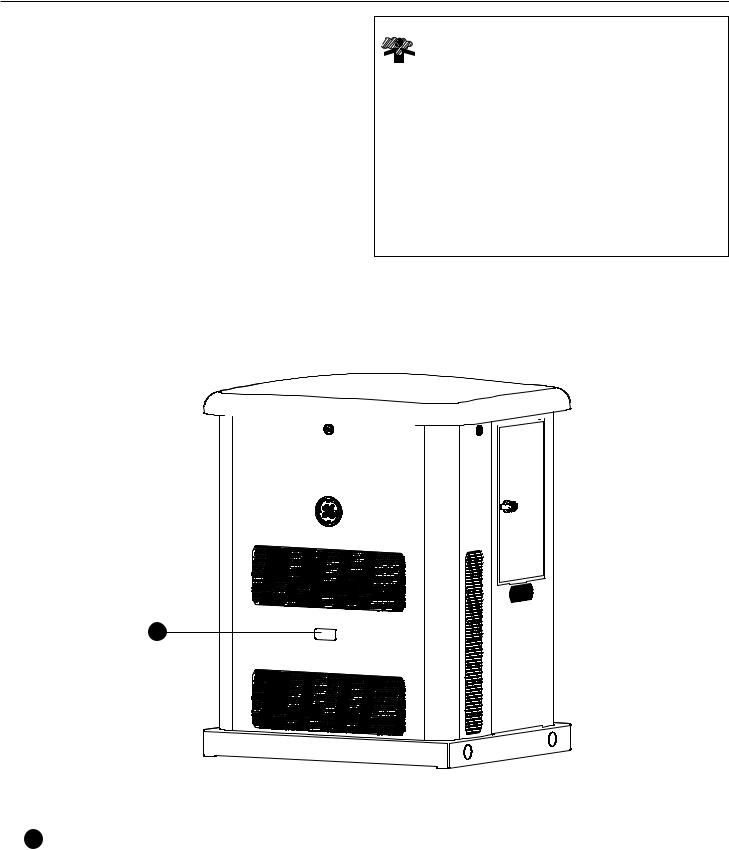
Generator Placement
Before installing the generator, consult with the homeowner and convey the following requirements, which must be satisfied before the installation is complete.
There are two equally important safety concerns in regards to carbon monoxide poisoning and fire. There are also several general location guidelines that must all be met before the installation is considered complete.
 WARNING Running engine gives off carbon monoxide, an
WARNING Running engine gives off carbon monoxide, an
odorless, colorless, poison gas.
Breathing carbon monoxide could result in death, serious injury, headache, fatigue, dizziness, vomiting, confusion,
seizures, nausea or fainting.
•Operate this product ONLY outdoors in an area that will not accumulate deadly exhaust gas.
•Keep exhaust gas away from any windows, doors, ventilation intakes, soffit vents, crawl spaces, open garage doors or other openings that can allow exhaust gas to enter inside or be drawn into a potentially occupied building or structure.
•Carbon monoxide detector(s) MUST be installed and maintained indoors according to the manufacturer’s instructions/ recommendations. Smoke alarms cannot detect carbon monoxide gas.
Exhaust Side of the Generator
A
NOT |
REPRODUCTION |
for |
|
A Exhaust outlet side of weatherproof enclosure.
11
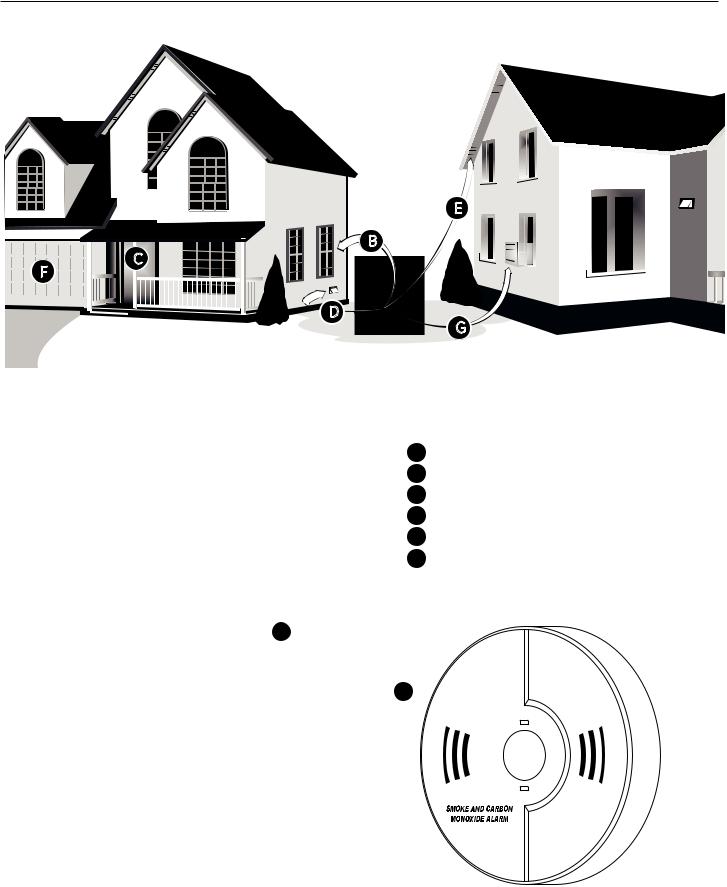
Placement of Standby Generator to
REDUCE THE RISK OF CARBON MONOXIDE POISONING
The arrows in the figure below point to potential points of entry for Carbon Monoxide Gas.
|
E |
|
B |
F |
C |
|
|
|
|
|
|
|
|
|
D |
|
|
|
|
|
|
|
|
|
|
|
|
|
|
|
|
Monoxide (CO) detector in operating conditionREPROin DUCTION |
|||||||
|
|
|
|
|
|
|
|
|
|
G |
All fossil fuel burning equipment, such as standby |
|
|
||||||||
generators, contains carbon monoxide (CO) gas in the engine |
• Ensure exhaust gas is kept away from: |
|||||||||
exhaust. CO gas is odorless, colorless and tasteless and is |
|
|
||||||||
|
|
|
|
|
|
|
|
NOT |
|
|
unlikely to be noticed until a person is overcome. CO gas can |
B |
windows |
||||||||
kill you so it is required that the following is included as part |
C |
doors |
||||||||
of the installation: |
|
D |
ventilation intakes |
|||||||
|
|
• Install generator outdoors in an area that will not |
||||||||
|
|
E |
soffit vents |
|||||||
|
|
|
accumulate deadly exhaust gas. |
|||||||
|
|
|
F |
|
||||||
|
|
• DO NOT install generator where exhaust gas could |
garage doors |
|||||||
|
|
G |
|
|||||||
|
|
|
accumulate and enter inside or be drawn into a |
crawl spaces or other openings that can allow |
||||||
|
|
|
potentially occupied building or structure.for |
|
exhaust gas to enter inside or be drawn into a |
|||||
• By law it is required in many states to have a Carbon |
potentially occupied building or structure. |
|
|
||
your home. Carbon monoxide detector(s) A MUST |
|
|
be installed and maintained indoors according to |
|
|
the manufacturer’s instructions/ recommendations. |
|
|
A CO monitor is an electronic device that detects |
A |
|
hazardous levels of CO. When there is a buildup of |
||
|
||
CO, the monitor will alert the occupants by flashing |
|
|
visual indicator light and alarm. Smoke alarms cannot |
|
|
detect CO gas. |
|
•Your neighbor(s) home may be exposed to the engine exhaust from your standby generator and must be considered when installing your standby generator.
12

•Direct the standby generator exhaust away from or parallel to the building or structure. DO NOT direct the generator exhaust towards a potentially occupied building, structure, windows, doors, ventilation intakes, soffit vents, crawl spaces, open garage doors or other openings where exhaust gas could accumulate and enter inside or be drawn into a potentially occupied building or structure.
STANDBY GENERATOR
ENGINE EXHAUST
• DO NOT place standby generator in any area where leaves or debris normally accumulates. Position
standby generator in an area where winds will carry the exhaust gas away from any potentiallyREPRODUCTIONoccupied building or structure.
13
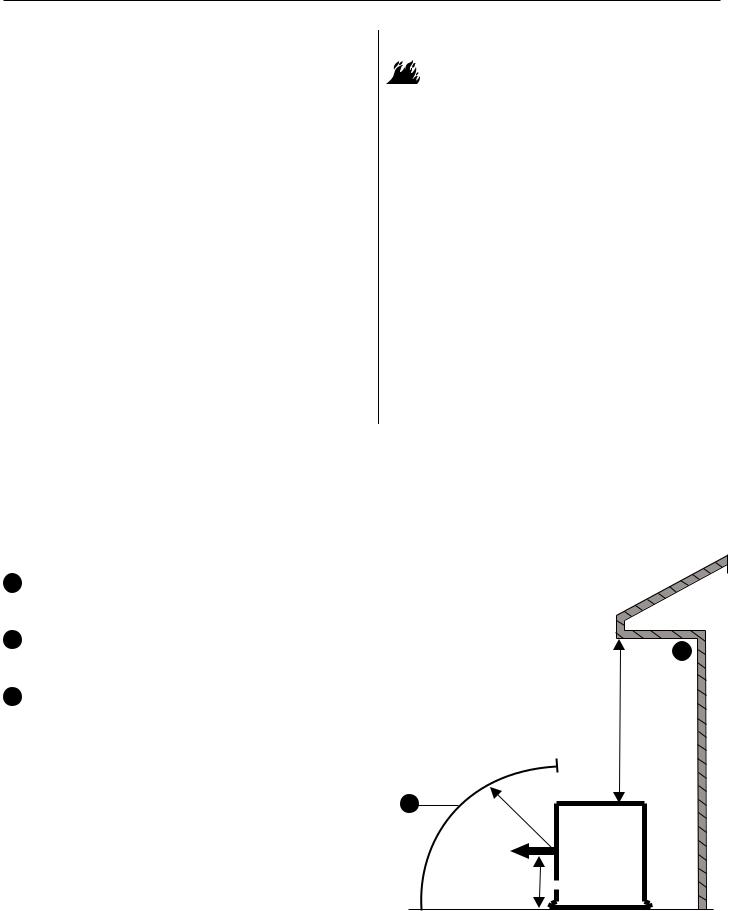
Placement of Standby Generator to REDUCE THE RISK OF FIRE
The National Fire Protection Association (NFPA) standard |
|
|
||
|
WARNING Exhaust heat/gases could ignite combustibles |
|||
NFPA 37 establishes criteria for minimizing the hazard |
|
or structures resulting in death or serious injury. |
||
of fire during the installation and operation of stationary |
|
|
||
combustion engines. NFPA 37 limits the spacing of an |
|
|
||
enclosed generator from openings in walls, structures and |
• |
Exhaust outlet side of weatherproof enclosure must have at least |
||
combustible materials outside the enclosure. |
|
|||
|
|
5 ft. (1.5 m) minimum clearance from any structure, shrubs, trees |
||
The placement requirements provided are based on |
|
or any kind of vegetation. |
||
compliance to NFPA 37 2010 section 4.1.4 and a full-scale |
• |
Standby generator weatherproof enclosure must be at least |
||
demonstration fire test. Details of compliance testing can be |
|
5 ft. (1.5 m) from windows, doors, any wall opening, shrubs or |
||
|
vegetation over 12 inches (30.5 cm) in height. |
|||
found in section National Fire Protection Association (NFPA) |
|
|||
• |
Standby generator weatherproof enclosure must have a minimum |
|||
standard NFPA 37 requirements and testing. |
|
|||
|
|
of 5 ft. (1.5 m) overhead clearance from any structure, overhang |
||
|
|
|
||
|
|
|
or trees. |
|
|
|
• |
DO NOT place weatherproof enclosure under a deck or other type |
|
|
|
|
of structure that may confine airflow. |
|
|
|
• |
Use only flexible steel fuel line provided. Connect provided fuel line |
|
|
|
|
to generator. DO NOT use with or substitute any other flexible fuel |
|
|
|
|
line. |
|
B |
|
• |
Smoke detector(s) MUST be installed and maintained indoors |
|
REPRODUCTION |
||||
|
|
|
according to the manufacturer’s instructions/recommendations. |
|
|
|
|
Carbon monoxide alarms cannot detect smoke. |
|
|
|
• |
DO NOT place weatherproof enclosure in manner other than |
|
|
|
|
shown in illustrations. |
|
|
|
NOT |
|
|
|
Examples of standby generator locations to reduce the |
|
|
|
||
risk of fire: |
|
|
|
|
|
Legend for Generator Locations to reduce the isk of fire. |
Vertical learances |
||||
A |
Standby weatherproof enclosureformust be at least 5 ft |
|
|
|
|
|
(1.5 m) from windows, doors, any wall opening, shrubs |
|
|
|
|
|
or vegetation over 12 inches (30.5 cm) in height. |
|
|
Structure |
|
|
Exhaust outlet side of weatherproof enclosure must |
|
|
||
|
|
|
C |
||
|
have at least 5 ft (1.5 m) minimum clearance from any |
|
|
||
|
|
|
|
||
|
structure, shrubs, trees or any kind of vegetation. |
|
|
|
|
C |
Standby weatherproof enclosure must have a |
|
|
|
|
|
minimum of 5 feet (1.5 m) overhead clearance from |
|
|
|
|
|
|
5 ft (1.5 m) |
|||
|
any structure, overhang or trees. |
|
|
|
|
NOTICE DO NOT place weatherproof enclosure under a deck or other type of covered structure that may confine airflow.
B |
|
|
|
|
|
|
|
|
|
5 ft (1.5 m) |
|
|
|
||
|
|
|
|
||||
|
|
|
|
|
|
|
|
|
|
|
|
|
|
Standby |
|
|
|
|
|
|
|||
|
Exhaust |
||||||
|
Direction |
|
|
||||
|
|
|
|
|
|
|
|
|
|
Center of Exhaust Panel |
|||||
14
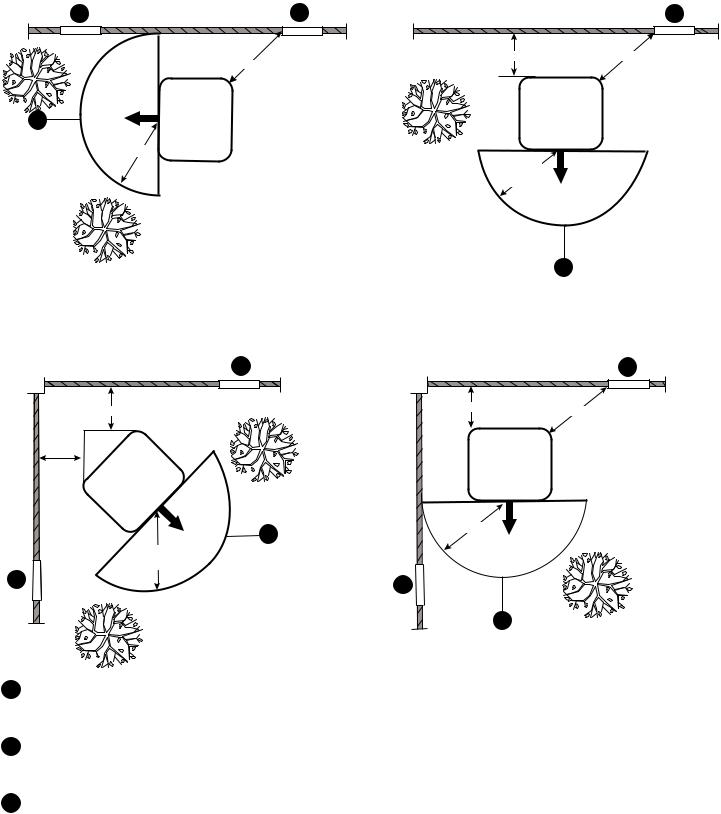
Generator Installations
NOTICE The figures below show the minimum installation distances allowed to structures and items listed in legend.
A |
Structure |
|
|
|
A |
|
Structure |
A |
|
|
|
5 ft (1.5 m) min |
|
18 in (45.7 cm) min |
|
5 ft (1.5 m) min |
|||
|
|
|
|
|
|
||||
|
Exhaust |
|
|
|
|
|
|
|
|
|
Direction |
|
|
|
|
|
|
|
|
B |
|
Standby |
|
|
|
|
Standby |
|
|
|
|
|
|
|
|
|
|
||
|
5 ft (1.5 m) |
|
|
|
|
|
5 ft |
|
|
|
|
|
|
|
|
|
|
|
|
|
|
|
|
|
|
|
(1.5 m) |
|
|
|
|
|
|
|
|
|
|
Exhaust |
|
|
|
|
|
|
|
|
|
Direction |
|
|
|
|
|
|
REPRODUCTION |
B |
|
||
|
Structure |
|
A |
|
|
A |
|||
|
|
|
|
|
Structure |
|
|||
|
18 in (45.7 cm) min |
|
|
|
|
|
18 in (45.7 cm) min |
5 ft (1.5 m) min |
|
|
NOT |
|
|
|
|
||||
|
|
|
|
|
Standby |
|
|
||
|
|
|
|
|
|
|
|
|
|
|
Standby |
|
|
|
|
|
|
|
|
|
|
Exhaust |
|
|
|
|
|
|
|
|
|
Direction |
|
|
|
|
|
|
|
|
|
|
|
B |
|
5 ft (1.5 m) |
|
|
|
|
|
|
|
|
|
|
|
||
|
5 ft |
|
for |
|
|
Exhaust |
|
|
|
A |
(1.5 m) |
|
|
|
Direction |
|
|
||
|
|
|
|
|
|
A |
|
|
|
|
|
|
|
|
|
|
|
|
|
B
AStandby weatherproof enclosure must be at least 5 ft (1.5 m) from windows, doors, any wall opening, shrubs or vegetation over 12 inches (30.5 cm) in height.
BExhaust outlet side of weatherproof enclosure must have at least 5 ft (1.5 m) minimum clearance from any structure, shrubs, trees or any kind of vegetation.
CStandby weatherproof enclosure must have a minimum of 5 feet (1.5 m) overhead clearance from any structure, overhang or trees.
NOTICE DO NOT place weatherproof enclosure under a deck or other type of covered structure that may confine airflow.
15

Other General Location Guidelines
•Place the standby generator in a prepared location that is flat and has provisions for water drainage.
•Install the standby generator in a location where sump pump discharge, rain gutter down spouts, roof run-off, landscape irrigation, or water sprinklers will not flood the unit or spray the enclosure and enter any air inlet or outlet openings.
•Install the standby generator where it will not affect or obstruct any services (including covered, concealed and underground), such as telephone, electric, fuel (natural gas / LPG vapor), irrigation, air conditioning, cable, septic, sewer, well and so forth.
•Install the standby generator where leaves, grass, snow, etc will not obstruct air inlet and outlet openings. If prevailing winds will cause blowing or drifting, you may need to construct a windbreak to protect the unit.
National Fire Protection Association (NF A) Standard NFPA 37 Requirements and Testing
Requirements: |
To comply with condition 2, the weatherproof enclosure has |
NFPA 37 2010, section 4. 1. 4, Engines Located Outdoors. |
been constructed completely of non-combustible materials |
Engines, and their weatherproof housings if provided, that |
and full-scale fire tests have been conducted to demonstrate |
are installed outdoors shall be located at least 1.5m (5 ft) |
that a fire within the enclosure will not ignite combustible |
|
materials outside the enclosure. |
from openings in walls and at least 1.5form (5 ft) om structures having combustible walls. A minimum separati n shall not be required where either of the following conditi ns exist:
1. The adjacent wall of the structure has a fire resistance rating of at least 1 hour.
NOT REPRODUCTION
2. The weatherproof enclosure is constructed of noncombustible materials and it has been
demonstrated that a fire within the enclosure will not ignite combustible materials outside the enclosure. *
Annex A Explanatory Material
A.4.1.4 (2) Means of demonstrating compliance are by means of full-scale fire tests or by calculation procedures, such as those given in NFPA 555, Guide on Methods for Evaluating Potential for Room Flashover.
16
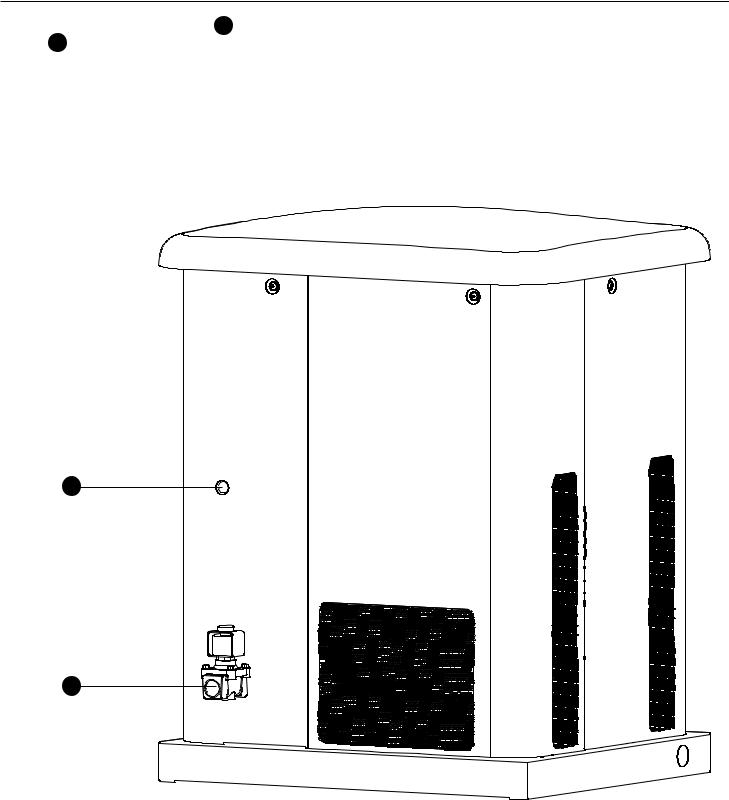
Electrical and Fuel Inlet Locations
The 3/4 inch N.P.T. fuel inlet connector A and electrical inlet location B is shown below.
A ½ inch knock-out is provided for the electrical inlet. This inlet may be enlarged or supplemented to accommodate a maximum conduit size of 1 ½ inches. Ensure that the installed conduit(s) enter the unit in the zone shown in the
drawing such that they properly enter the electrical box and do not interfere with the fully opened roof.
The home generator is supplied with a base that, unless mandated by local code, does not require a concrete slab.
B
A
NOT |
REPRODUCTION |
for |
|
17
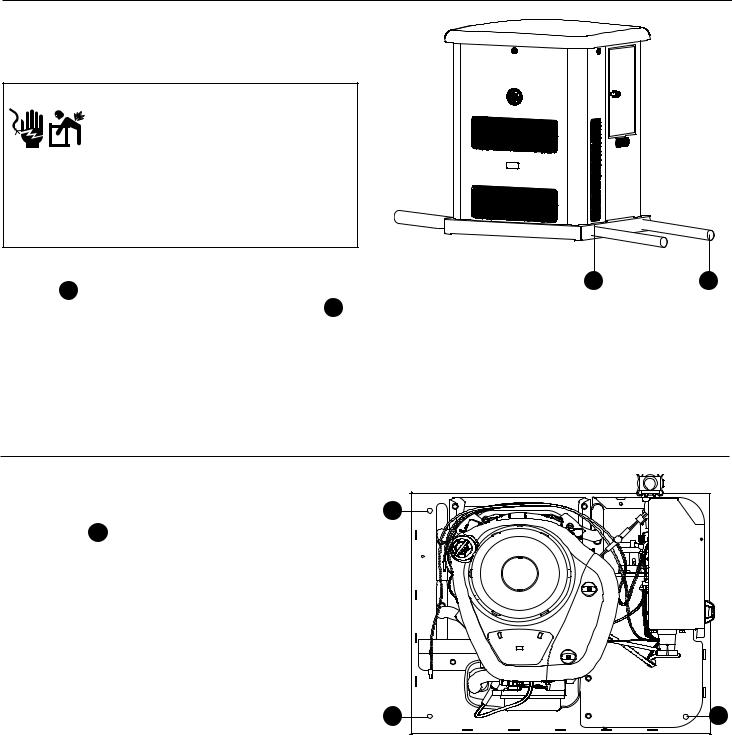
Lifting the Generator
The generator weighs more than 330 pounds (150 kg). Proper tools, equipment and qualified personnel should be used in all phases of handling and moving the generator.
 WARNING Hazardous Voltage - Contact with power lines could cause electric shock or burn, resulting in death or serious injury.
WARNING Hazardous Voltage - Contact with power lines could cause electric shock or burn, resulting in death or serious injury.
Lifting Hazard / Heavy Object - Could result in serious injury.
• If lifting or hoisting equipment is used, DO NOT contact any power lines.
• DO NOT lift or move generator without assistance.
• Use lifting pipes as described in Lifting the Generator.
• DO NOT lift unit by roof as damage to generator will occur.
Two 60” lengths of 3/4” nominal minimum scheduled 40 |
|
B |
|||
steel pipe A , supplied by the installer, are required to lift the |
|||||
|
|||||
generator manually. Insert pipes through the lifting holes |
B |
|
|||
located near the unit’s base. |
|
|
|
|
|
You may also lift the unit using a “hook and hoist” method |
|
|
|||
attached to the lifting pipes, provided that you use a |
|
|
|||
spreader bar to ensure that the chains or cables DO NOT |
|
|
|||
touch the generator’s roof. |
|
|
|
|
|
Concrete Anchoring of Unit |
|
|
|
||
In areas determined to be hurricane prone, it is |
|
|
|
||
recommended to anchor the standby generator to concrete. |
|
||||
The concrete anchors must be rated to hold 800 lbs ( kg). |
C |
|
|||
There are three C 7/16 inch hole locations in the base of |
|
|
|||
the generator in which to anchor the unit. |
|
|
|
||
|
NOT |
|
|
|
|
NOTICE Unless mandated by local or state code, a concrete |
|
||||
slab is not required. |
for |
REPRODUCTION |
|
||
|
|
||||
|
|
|
|||
C
A
C
18
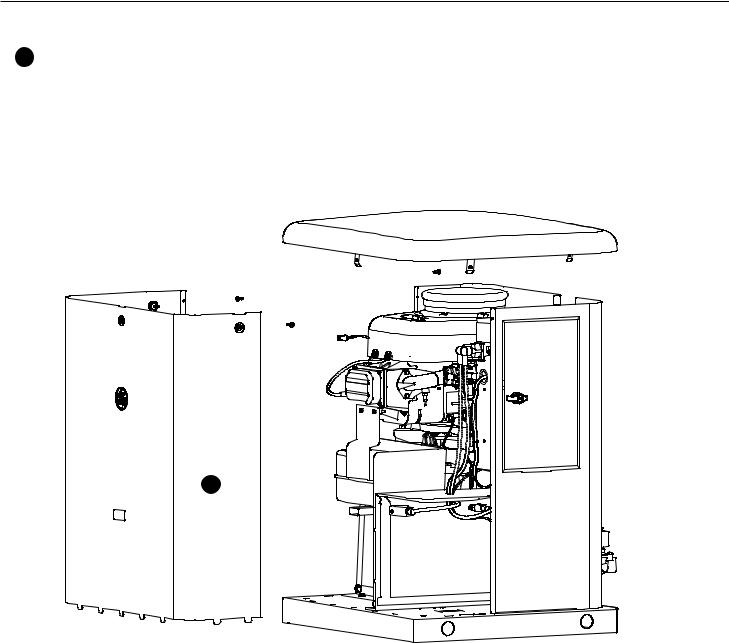
Access Panels
The generator is equipped with an enclosure that has several access panels, as shown.
A |
Front Panel that is used to access: |
Each generator is shipped with a set of identical keys. |
|
||
|
• Battery Compartment |
|
|
• Engine Oil Drain Hose |
|
|
• Engine Oil Filter |
|
|
• Engine Valve Cover |
|
|
• Spark Plugs |
|
B
NOT |
REPRODUCTION |
A |
|
for |
|
19
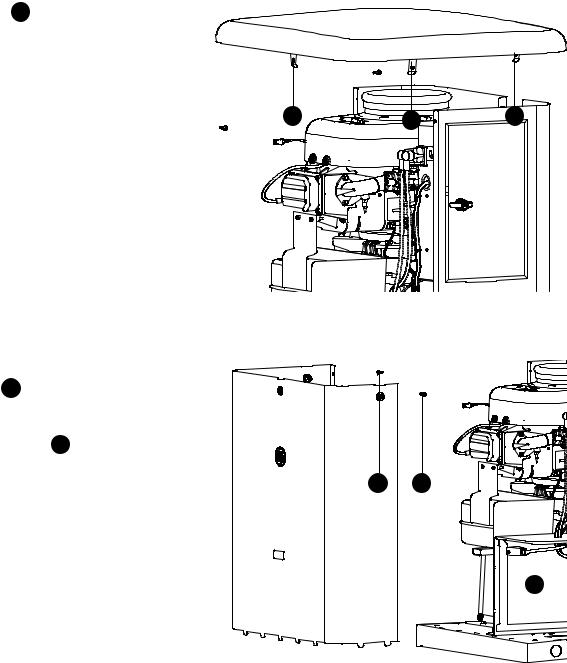
To remove roof:
1. Remove the five screws A that secure the roof to the unit.
2. Carefully lift and remove roof from unit.
A |
A |
A |
To remove front panel: |
|
REPRODUCTION |
|
||
|
|
|
|
||
1. |
Remove the two screws B |
that secure the panel to the |
|
|
|
|
unit. |
|
|
|
|
2. |
Lift and flex panel outward and off base. Use caution |
|
|
||
|
not to damage the battery box C . |
|
|
|
|
To secure front panel: |
NOT |
|
|
|
|
1. |
Place panel in unit. |
|
B |
B |
|
|
|
||||
2. |
Secure the panel with two screws. |
|
|
|
|
|
|
for |
|
|
C |
|
|
|
|
|
|
20
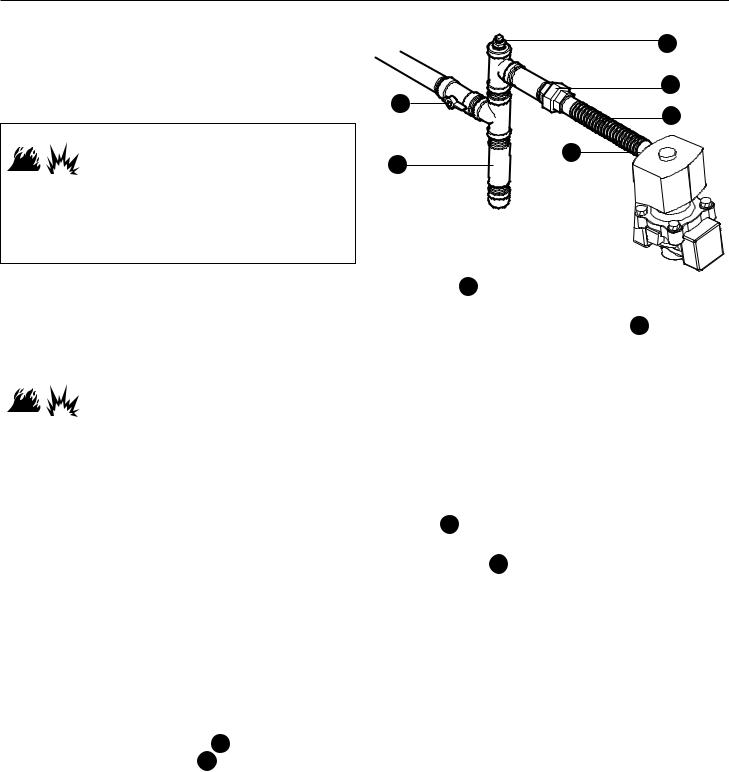
The Gaseous Fuel System |
|
|
|
The information below is provided to assist gaseous |
|
D |
|
fuel system technicians in planning installations. In no |
|
||
|
|
||
way should this information be interpreted to override |
|
|
|
applicable fuel gas codes. Consult with your local fuel |
|
C |
|
supplier or Fire Marshall if questions or problems arise. |
E |
B |
|
|
|
||
WARNING Propane and Natural Gas are extremely flammable |
|
|
|
and explosive, which could cause burns, fire or |
|
A |
|
explosion resulting in death or serious injury. |
F |
||
|
• LP gas is heavier than air and will settle in low areas.
• Natural gas is lighter than air and will collect in high areas.
•The slightest spark could ignite these fuels and cause an explosion.
•DO NOT light a cigarette or smoke.
TO THE INSTaLLER: Consult with the generator owner(s) and |
• |
A union C or flanged connection shall be provided |
|||
convey any technical considerations that might affect their |
|||||
|
downstream to permit removal of standby. |
||||
installation plans before applying these general guidelines. |
|
||||
• |
A manometer port should be provided D . A digital |
||||
The following general rules apply to gaseous fuel |
|||||
|
manometer, P/N 19495, is available at your Briggs & |
||||
system piping: |
|
|
|
||
|
|
|
Stratton service center. When the initial test runs are |
||
|
|
|
|
||
WARNING Propane and Natural Gas are extremely flammable |
|
completed, the manometer is removed and the port |
|||
and explosive, which could cause burns, fire or |
|
is plugged. The manometer port permits temporary |
|||
explosion resulting in death or serious injury. |
|
||||
|
installation of a manometer to ensure that the |
||||
|
|
|
|
||
• Before placing the generator into service, the fuel system lines |
|
engine receives the correct fuel pressure to operate |
|||
|
efficiently throughout its operating range. |
||||
must be properly purged and leak tested. |
|
|
|||
• No leakage is permitted. |
|
|
• |
Where the formation of hydrates or ice is known to |
|
|
|
|
|
occur, piping should be protected against freezing. The |
|
NOTICE The supplied flexible steel fuel line is not to be installed |
|
||||
|
termination of hard piping should include a sediment |
||||
underground or in contact with the ground. |
|
|
trap F where condensate is not likely to freeze. |
||
• The entire flexible steel fuel line must be visible for |
|
||||
• A minimum of one accessible, approved manual |
|||||
periodic inspection and mustNOTnot be c ncealed within |
|||||
|
shutoff valve E shall be installed in the fuel supply |
||||
nor contact nor run through any wall, l r, or partition. |
|
||||
|
line within 6 ft. (180 cm) of the home generator. |
||||
• The piping should be of a materialforthat conforms |
|
||||
• A manual fuel shut-off valve should be installed in the |
|||||
to federal and local codes, rigidly mounted and |
|||||
|
interior of the building. |
||||
protected against vibration. |
|
|
|
||
|
REPRODUCTION |
||||
|
|
||||
• Piping should be protected from physical damage |
• Where local conditions include earthquake, |
||||
|
tornado, unstable ground, or flood hazards, special |
||||
where it passes through flower beds, shrub beds, and |
|
||||
|
consideration shall be given to increase strength and |
||||
other cultivated areas where damage could occur. |
|
||||
|
flexibility of piping supports and connections. |
||||
NOTICE The illustration is representative of a typical |
|
||||
• Piping must be of the correct size to maintain the |
|||||
installation. Your installation may differ. |
|
||||
|
|
required supply pressures and volume flow under |
|||
• Install the flexible steel fuel line |
B (supplied) between |
|
|||
|
varying generator load conditions with all gas |
||||
the generator fuel inlet port A |
and rigid piping |
|
|||
|
appliances connected to the fuel system turned on |
||||
to prevent thermal expansion, contraction, or any |
and operating. |
|
standby movement from causing excessive stress on |
||
• Use a pipe sealant or joint compound approved for |
||
the piping material. |
||
use with NG/LPG on all threaded fittings to reduce the |
||
|
||
|
possibility of leakage. |
|
|
• Installed piping must be properly purged and |
|
|
leak tested, in accordance with applicable codes |
|
|
and standards. |
21

Fuel Pressure
Both LP vapor and natural gas fuel supply pressure at the generator’s fuel inlet port should be between the following levels at full load with all gas appliances turned on and operating.
• NG is 5-7” W.C.
• LP is 11-14” W.C.
Ensure that all gas line shutoff valves are OPEN and that adequate fuel pressure is available whenever automatic operation is desired.
|
• In engines set up to run on propane (LP), commercial |
Power Loss |
|||
|
grade HD5 propane with a minimum fuel energy of |
||||
|
Air density is less at high altitudes, resulting in less available |
||||
|
2500 BTUs/ft3 with maximum propylene content of |
||||
|
5% and butane and heavier gas content of 2.5% and |
engine power. Specifically, engine power will decrease 3.5% |
|||
|
minimum propane content of 90% is required. |
for each 1,000 feet (300 m) above sea level and 1% for |
|||
Natural gas rating will depend on specific fuel but typical |
each 10° F (5.6°C) above 77°F (25°C). Generators located in |
||||
these conditions must have their transfer switch adjusted |
|||||
derates are between 10 to 20% off the LP gas rating. |
|||||
appropriately for this power decrease. See Automatic |
|||||
Natural gas or LP engines are certified to operate on natural |
|||||
Transfer Switch manual on how to adjust for the power |
|||||
or liquid propane gas. The emissions control system for this |
|||||
decrease. |
|||||
engine is EM (Engine Modifications). |
|
|
|||
|
|
Fuel Pipe Sizing |
|||
|
|
|
|
||
|
|
|
|
There are numerous on-line or otherwise-published |
|
|
|
|
|
references for fuel pipe sizing. For example, NFPA 54 - |
|
|
|
|
|
National Fuel Gas Code, 2006 (Item #: 320-6031-06) is a |
|
|
WARNING Propane and Natural Gas are extremely flammable |
common resource. |
|||
|
and explosive, which could cause burns, fire or |
The installer should consider the specific gravity of gas |
|||
|
explosion resulting in death or serious injury. |
||||
|
and compensate for a nominal amount of restriction from |
||||
|
The residential generator is equippedNOTwith an aut matic safety |
||||
• |
bends, fittings, etc. If an unusual number of fittings, bends, or |
||||
|
gas “fuel shut-off” valve. |
|
|
other restrictions are used, refer to federal and local codes |
|
• |
DO NOT operate the equipment if the “fuel shut-off” valve is |
for guidance. |
|||
|
missing or inoperative. |
for |
REPRODUCTION |
||
|
|
||||
|
|
|
|||
22
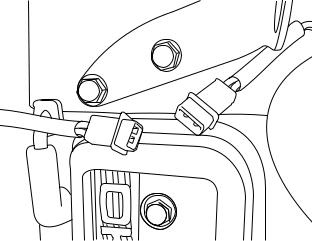
Fuel Conversion
The engine of your home generator system is factory calibrated to run on natural gas (NG). It may also be operated on liquefied petroleum (LP) vapor.
To configure the 8 kW fuel system for LP use:
1.Set generator’s system switch to OFF.
2.Remove 15 Amp fuse from control panel.
3.Remove roof and side panels.
4.Change main jet in fuel mixer following instructions provided in LP Conversion Kit.
5.Replace side panels and roof.
6. Reinstall 15 Amp fuse in control panel.
7.Set generator’s system switch to AUto.
The system is now ready to operate automatically using LP vapor fuel.
|
|
|
REPRODUCTION |
To configure the 10 kW fuel system for LP use: |
|||
1. |
Set generator’s system switch to OFF. |
|
|
2. |
|
NOT |
|
Remove 15 Amp fuse from control panel. |
|||
3. |
Open oil fill access panel. |
|
|
4. |
Connect the fuel select solenoid by joining the two-pin |
||
|
electrical connector. |
for |
|
|
|
|
|
5. |
Reinstall 15 Amp fuse in control panel. |
|
|
6. |
Set generator’s system switch to AUto. |
|
|
7. |
Close access panels. |
|
|
The system is now ready to operate automatically using
LP vapor fuel.
23

Fuel Consumption
Estimated fuel supply requirements at half and full load for natural gas and LP vapor fuels are shown here.
LP Vapor (Propane)
|
|
10 kW |
8 kW |
|
Cu Ft/Hr |
65.6 |
56.4 |
Full Load |
|
|
|
Gal/Hr (liquid) |
1.82 |
1.57 |
|
|
BTU/Hr |
164000 |
141000 |
|
|
|
|
|
Cu Ft/Hr |
42.8 |
37.6 |
|
|
|
|
1/2 Load |
Gal/Hr (liquid) |
1.18 |
1.04 |
|
BTU/Hr |
107000 |
94000 |
|
|
|
|
|
Cu Ft/Hr |
23.6 |
20 |
|
|
|
|
Exercise |
Gal/Hr (liquid) |
0.65 |
0.55 |
|
BTU/Hr |
59000 |
50000 |
|
|
|
|
Recommended Energy |
Natural Gas |
Propane |
Content of Fuel: |
|
(LP Vapor) |
Heating Value: |
|
|
BTU per gallon liquid |
N/A |
91,547 |
(gross*) |
|
|
BTU per Cubic feet |
1,000 |
2,500 |
(vapor) |
|
|
|
|
|
Natural Gas |
|
|
REPRODUCTION |
||
|
|
|
|
||
|
|
|
|
|
|
|
|
10 kW |
8 kW |
|
|
|
|
|
|
|
|
Full Load |
Cu Ft/ Hr |
169 |
121 |
|
|
|
|
|
|
|
|
BTU / Hr |
169000 |
121000 |
|
||
|
|
||||
|
Cu Ft/ Hr |
111 |
94 |
|
|
1/2 Load |
|
NOT |
|
|
|
BTU / Hr |
111000 |
94000 |
|
|
|
|
|
|
|||
|
|
|
|
|
|
Exercise |
Cu Ft/ Hr |
60 |
53 |
|
|
BTU / Hr |
60000 |
53000 |
|
|
|
|
|
|
|||
|
|
|
for |
|
|
24
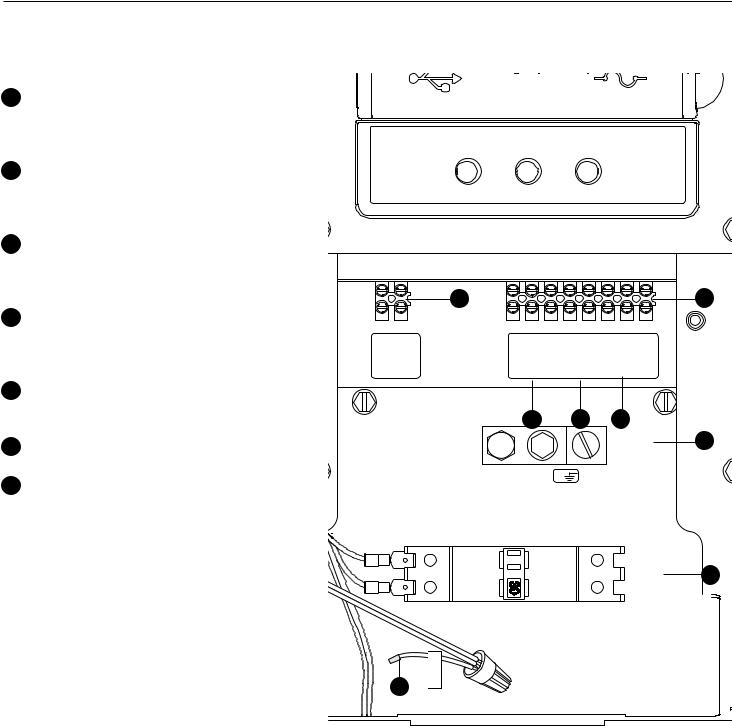
System Connectors
Low Voltage connections to signal fault contacts, transfer switch communication and auxiliary 12VDC power are made via a field connection terminal block in control board area. Compare this illustration with your generator to familiarize yourself with the location of these connections.
A- two Pin Terminal Block — Used to connect utility 240 VAC from fuse block in ATS to the control board. Connect only one wire per terminal.
B- fault Contacts — Use NO, COM and NC to hook up a siren, light, etc. to alert you in case of a fault. Contacts reverse state (NO goes to NC
and vice versa) upon a fault condition.
C |
– Transfer Switch Communication (TxRx and |
|
|
|
|
|
|
|
TxRx GND) — Connect to transfer switch |
|
|
|
|
|
|
|
control board for communication interface |
|
|
|
|
|
|
|
using 18AWG twisted pair wire. |
|
|
|
A |
|
|
D |
– +LED and GND Connection — Not required for |
|
|
|
|
|
|
|
wireless monitor included with unit. Available |
1 |
2 |
|
|
|
|
|
panel accessory, #6154. |
REPRODUCTION |
|
||||
|
|
UTILITY |
UTILITY |
] |
|||
|
for optional hardwired remote system status |
|
|
. |
COM |
.C. |
|
|
|
|
|
|
. |
|
|
E |
- eight Pin Terminal Block — Used to connect |
|
|
|
|
|
|
|
signal wires to the control board. Connect only |
|
|
|
B |
|
|
|
one wire per terminal. |
|
|
|
|
|
|
F |
- Power Connection (Line 1 and Line 2) — Power |
|
|
|
|
|
|
|
NOT |
|
|
|
|
|
|
|
connection to transfer switch. |
|
|
|
|
|
GND |
G |
- neutral and Ground Connection — Connect to |
|
|
|
|
|
|
|
transfer switch neutral and ground |
|
|
|
|
|
|
|
for |
|
|
|
|
|
|
|
|
|
E |
TxRx |
TxRxGND |
+LEDGNDN/C |
|
] ] |
|
||
C |
|
D |
|
|
|
GROUND] |
G |
LINE 1 |
] |
|
LINE 2 |
F |
G
 NEUTRAL
NEUTRAL
•For power output connection (Line 1, Line 2, Neutral, and Ground), 300V, 10 AWG copper wire, or 300V, 8 AWG aluminum wire, (ref. NEC Table 310.16, 100 ft. Use National Electric Code for correction factors and wire size calculations).
•For utility circuit connection (Utility A and Utility B) use #14 AWG minimum 300 volt wire.
•For transfer switch communication use #18 AWG twisted pair conductors, no greater than 200 ft in length, 300 volt wire.
•When connecting to the terminal block, fasten only one wire to each connector screw.
•Torque terminal block screws to 4.4 in-lb (0.49 Newton meter).
•Torque circuit breaker connections to 45 in-lb (5 Newton meter).
25
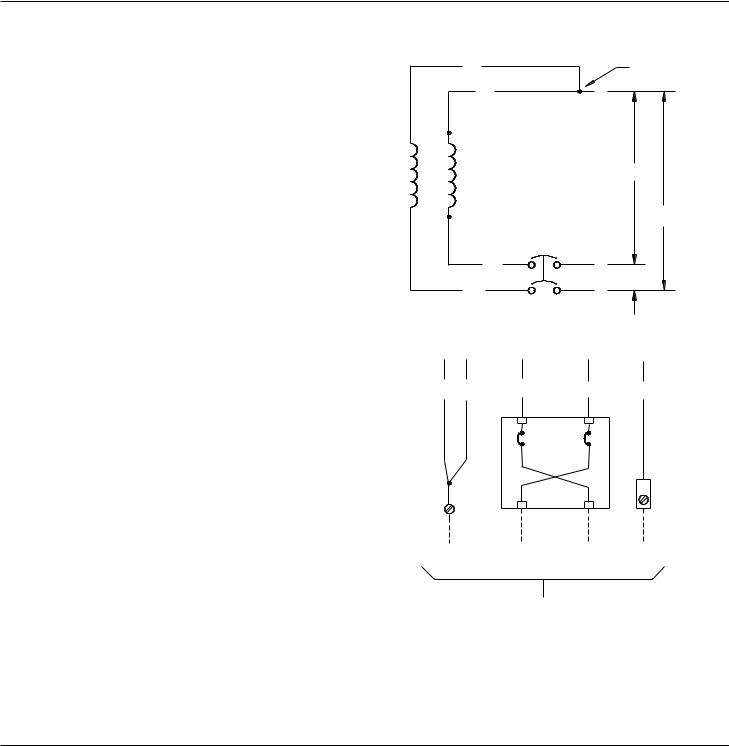
Generator AC Connection System
A single-phase, three-wire AC connection system is used in the home generator. The stator assembly consists of a pair of stationary windings with two leads brought out of each winding. The junction of leads 22 and 33 forms the neutral lead, as shown schematically and as a wiring diagram. A complete schematic and wiring diagram can be found later in this manual.
NOTICE Neutral is not bonded to ground at generator.
NOTICE Generator must be used with only an UL approved transfer switch that is compatible with the generator.
 WindingPower
WindingPower
33 |
Neutral |
22
|
120V |
|
Circuit |
120V |
|
|
||
Breaker |
|
|
11 |
240V |
|
44 |
||
|
NOT for
REPRODUCTION |
11 |
||
22 |
33 |
44 |
|
|
|
Circuit |
|
|
|
Breaker |
|
Neutral |
Line 2 |
Line 1 |
|
0
Ground
Grounding the Generator
The home generator must be installed as part of a system that includes a listed transfer switch, with neutral to ground bonding at the transfer switch in accordance with installation instructions. Unless mandated by local code, additional grounding to earth at the generator is not required. Any grounding at generator must use metal
piercing lock washers (or equal), UL listed terminals installed per terminal supplier’s instructions, and comply with national electrical codes and local requirements.
26
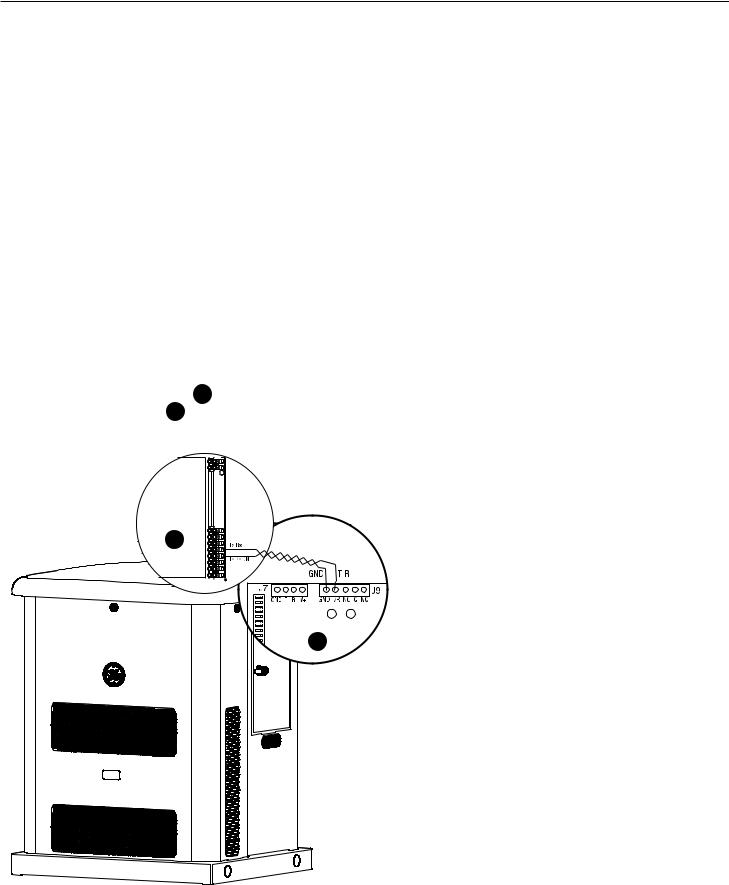
Power Connections from Generator to Transfer Switch
Utility Circuit Connection
“240V Utility” leads must be routed in conduit. The “240V Utility” leads deliver power to the generator’s circuit board, optional battery warmer and optional oil warmer. This power also charges the battery. When power on these leads is lost, the generator will start.
Generator Power Connection
For 8kW Units: Using installer supplied minimum 300V, 90°, 10 AWG copper wire, or 300V, 90°, 8 AWG aluminum wire*, connect generator power output Line 1, Line 2, neutral and ground to the corresponding Line 1, Line 2, neutral and ground in the transfer switch.
*Use National Electric Code for correction factors and wire size calculations.
Using installer-supplied minimum 300V, 14 AWG wire, connect each control circuit terminal in the generator (Utility A and Utility B) to the fuse block in the automatic transfer switch.
Reference illustration on page 26 for further information.
For 10kW Units: Using installer supplied minimum 300V, 90°, 8 AWG copper wire, or 300V, 90°, 6 AWG aluminum wire*, connect generator power output Line 1, Line 2, neutral and ground to the corresponding Line 1, Line 2, neutral and ground in the transfer switch.
*Use National Electric Code for correction factors and wire size calculations.
Transfer Switch Communication |
When making connections, obey wire type and torque |
|
specifications printed on the circuit breaker and neutral/ |
||
Using installer supplied #18 AWG twisted pair conductors, no |
||
ground connectors. |
||
greater than 200 ft in length, connect Tx Rx and Tx Rx GND |
||
|
||
from the generator terminal block A to T/R and GND on the |
|
|
transfer switch control board B . |
|
NOT REPRODUCTION
A for
B
27
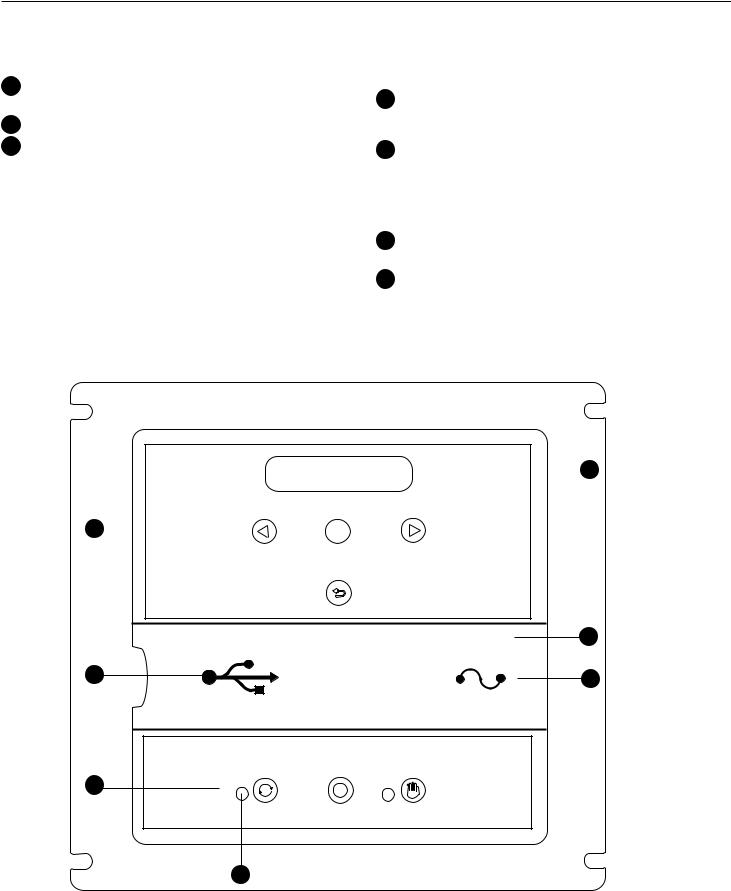
System Control Board
The generator control board, located inside the generator, |
|
|
|
|
|
|||||||
under the roof, is shown below. Brief descriptions of the |
|
|
|
|
|
|
||||||
controls used during installation are: |
|
|
|
|
•“MANUaL” Used to manually start the generator. |
|||||||
A |
- Menu/Programming Navigation Buttons — See Menu |
|
||||||||||
* |
- “AUTo” LED — LED will light when unit is placed into |
|||||||||||
|
section for details |
|
|
|
|
|
||||||
|
|
|
|
|
|
|
|
Auto mode. LED will blink if exercise cycle is not set or |
||||
B |
- Mini USB Port — Authorized Dealer Service Use Only |
|
|
|
||||||||
|
|
|
set to OFF. |
|
||||||||
C |
- Generator Operation Control Buttons — |
|
|
|
D |
– 15 Amp Fuse — Protects the home generator DC |
||||||
|
•“Auto” Normal operating position. Press and hold |
|
|
|
|
control circuits. If the fuse has ‘blown’ (melted open) |
||||||
|
button to put unit into Automatic mode. If an utility |
|
|
|
or was removed, the engine cannot crank or start. |
|||||||
|
power outage is sensed, the system will start the |
|
|
|
|
Replace the fuse using only an identical ATO 15A fuse. |
||||||
|
generator. When utility power is restored, auto lets the |
|
|
One spare fuse is supplied with the unit. |
||||||||
|
engine stabilize internal temperatures, shuts off the |
|
E |
- cover — This protective cover must be opened to |
||||||||
|
generator, and waits for the next utility outage. |
|
|
|||||||||
|
|
|
|
|
access the fuse and the USB port. |
|||||||
|
•“OFF” Turns off running generator, prevents unit from |
|
|
|
||||||||
|
|
F |
- Digital Display — Displays generator mode, menu |
|||||||||
|
starting, and resets any detected faults. |
|
|
|
||||||||
|
|
|
|
|
|
options, service codes, and service engine indicators |
||||||
OFF must be pressed and held for more than 5 seconds in |
|
|
|
|||||||||
|
More information may be found in Controls in the |
|||||||||||
order to reset service codes. |
|
|
|
|
|
|||||||
|
|
|
|
|
operator’s manual. |
|
||||||
|
|
|
|
|
|
|
|
|
||||
|
|
|
NOT |
REPRODUCTION |
E |
|||||||
|
|
|
|
|
|
menu |
|
|
|
F |
||
|
A |
|
|
for |
|
|
ok |
|
|
|
|
|
|
|
|
|
|
|
esc |
|
|
|
|
||
|
|
|
|
|
|
|
|
|
|
|
||
B |
D |
|
auto |
off |
manual |
C
*
28
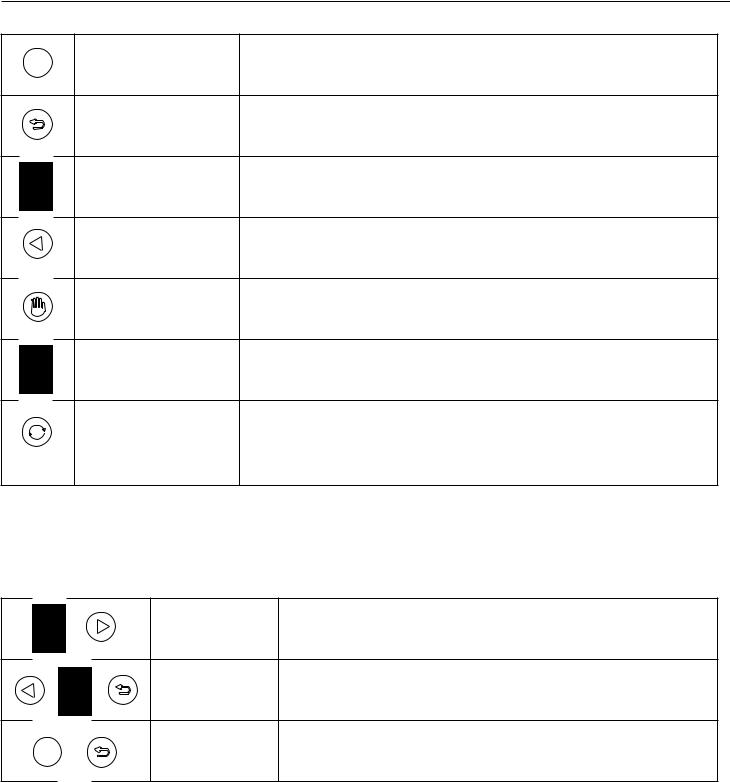
Menu
The following chart shows the icons for the buttons that control the system control panel.
ok |
MENU |
ENTER THE MENU (VIEW SETTINGS) |
|
PRESS TO CONFIRM SELECTION WHEN PROGRAMMING. |
|||
|
|
RETURN TO LAST MENU ITEM
|
RIGHT ARROW |
TOGGLE THROUGH MENU OPTIONS |
|
|
SETTING SYSTEM PARAMETERS |
||
|
|
||
|
LEFT ARROW |
TOGGLE THROUGH MENU OPTIONS |
|
|
SETTING SYSTEM PARAMETERS |
||
|
|
||
|
MANUAL MODE |
USED TO MANUALLY START THE GENERATOR. PRESS AND HOLD BUTTON TO START |
|
|
THE GENERATOR. |
||
|
|
||
|
OFF |
TURNS OFF RUNNING GENERATOR, PREVENTS U IT FROM STARTING, AND RESETS |
|
|
ANY DETECTED FAULTS. |
||
|
|
||
|
|
NORMAL OPERATING POSITION. PRESS AND HOLD BUTTON TO PUT UNIT INTO |
|
|
AUTOMATIC MODE |
AUTOMATIC MODE. IF A UTILITY POWER OU AGE IS SENSED, THE |
|
|
SYSTEM WILL START THE GENERATOR. WHEN UTILITY POWER IS RESTORED, AUTO |
||
|
|
LETS THE ENGINE STABILIZE INTERNAL TEMPERATURES, SHUTS OFF THE GENERA- |
|
|
|
OR, AND WAITS FOR THE NEXT TILITY POWER OUTAGE. |
|
|
NOT |
|
|
The following chart describes key sequences r accessing different programming modes; |
|||
|
GENERAL for |
ESS AND HOLD [ARRoW LEFt AND ARRoW RIGHT] FOR |
|
|
SET-UP |
|
THREE SECONDS TO ENTER THE PROGRAM MODE. |
|
|
|
REPRODUCTION |
|
ADVANCED |
|
PRESS AND HOLD [ARRoW LEFt, ARRoW RIGHT AND ESC] FOR |
|
SETTINGS |
|
THREE SECONDS TO ENTER THE ADVANCED SETTINGS MODE. |
|
WIRELESS |
|
PRESS AND HOLD [MENU AND ESC] FOR THREE SECONDS TO |
ok |
LINK MODE |
|
ENTER THE WIRELESS LINKING MODE. (ONLY APPLICABLE ON |
|
|
|
SOME MODELS). |
29
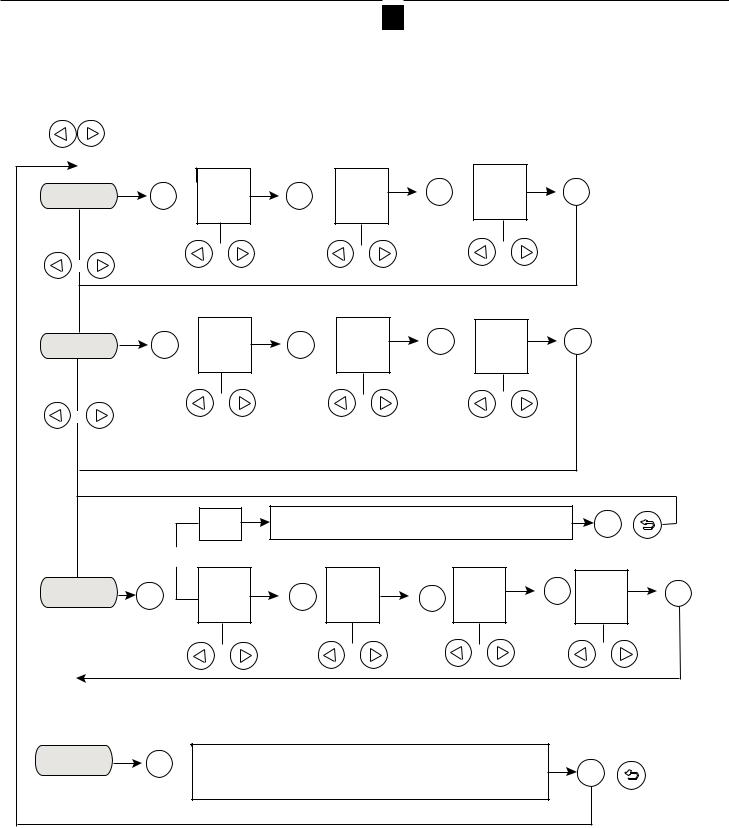
General Set Up Screen
For general set up, press and hold the left arrow and right arrow
 for 3 seconds. Follow the prompts as outlined below.
for 3 seconds. Follow the prompts as outlined below.
NOTE: Date and Time were set at the factory and stored in the control panel memory. The Exercise Cycle was also set at the factory. The default exercise cycle occurs on Tuesdays, at 2:00 P.M. Central Standard Time.
To updated or change these settings, follow the steps below.
SET DATE |
ok |
YEAR |
ok |
MONTH |
ok |
DAY## |
ok |
FLASHING |
FLASHING |
|
FLASHING |
|
|||
|
|
|
|
|
|||
or |
|
or |
|
or |
|
or |
|
|
|
|
|
|
|
|
|
|
|
|
REPRODUCTION |
|
ok |
|
||||
SET TIME |
|
ok |
HOURS |
|
ok |
MIN |
ok |
AM/PM |
|
|
|
|
|
|
FLASHING |
|
|
FLASHING |
|
FLASHI G |
|
|
|
or |
|
|
or |
|
|
or |
|
or |
|
|
|
|
|
|
orNOT |
|
If set to OFF, display will read: EXERCISE CYCLE OFF |
ok or |
|
||||
|
|
|
OFF |
|
|
||||||
SET EXERCISE |
ok |
|
for |
ok |
HOURS |
ok |
MIN |
ok |
AM/PM |
ok |
|
|
|
DAY OF WEEK |
|
|
|
|
|
||||
CYCLE |
|
|
FLASHING |
|
|
FLASHING |
|
FLASHING |
|
FLASHING |
|
|
|
|
or |
|
|
or |
|
or |
|
or |
|
EVENT |
ok |
Display will scroll last service code event, date, time, and |
|
|
|
LOG |
ok |
or |
|||
|
temperature of when the event occured. |
||||
|
|
||||
|
|
|
|
30
